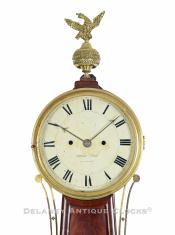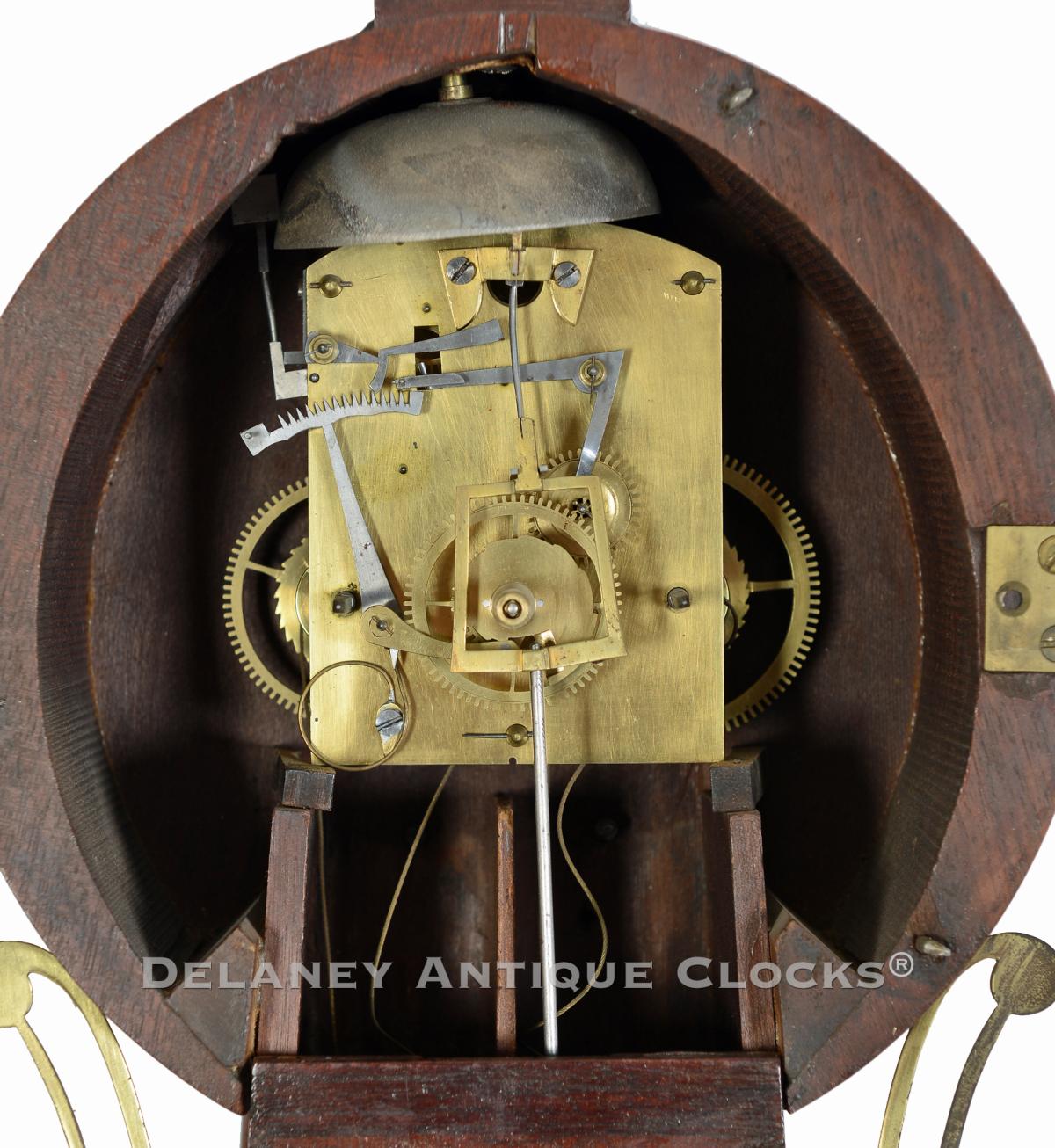William Grant. A full-striking wall clock. Boston, Massachusetts. 224087.
Introducing a striking banjo clock, a rare piece of history crafted by the skilled hands of the Boston, Massachusetts clockmaker William Grant.
Full-striking banjo clocks are very difficult to find in today’s marketplace. This is because they would have been much more expensive to manufacture than the standard timepiece version. In addition, they required an additional weight to power the strike train, making the clock very heavy and putting the clock at a higher risk of falling off the wall if not appropriately secured.
This example measures approximately 32.75 inches long from the bottom of the lower box to the top of the center finial, 10 inches wide across the lower box, and 4 inches deep. The painted iron dial measures approximately 9 inches in diameter.
This is a fine example. The case is constructed in mahogany, and its second finish enhances the grain patterns exhibited in the wood. At the top of the case is a decorative brass eagle and ball finial, a common motif in American Federal period furniture and decorative arts, symbolizing freedom and strength. It is fitted onto a stepped mahogany plinth. The dial bezel and the side arms are also brass. The glass in the bezel protects the dial. The bezel is hinged and opens to allow one access to the clock’s arrow-formed steel hands and two winding arbors. This painted iron dial is signed, “William Grant / Boston.” The throat and lower door frames feature half-rounded moldings and are fitted with mahogany veneered wooden panels. Both panels feature excellent grain patterns and are interesting to observe. The lower door opens to access the brass-faced pendulum bob and rating nut.
The movement is constructed in brass and features a full rack-and-snail striking train. This weight-driven clock is designed to run for eight days on a full wind and strike the hour on the hour on a bell mounted inside the case. The brass plates are rounded at the top and slightly shaped on the sides. They are supported by three posts and mounted inside the case to the backboard with screws. Hardened steel shafts support the brass gearing and recoil escapement. The two lead drive weights descend side-by-side below the works. The pendulum is mounted to a bridge on the front plate. This movement is of good quality.
Please read Paul Foley’s book, Willard’s Patent Timepieces, for a more detailed discussion regarding wall timepieces and their significance in the history of American clockmaking. The book provides a comprehensive overview of the development of wall timepieces in America, including the work of the renowned Willard clockmakers and their impact on the history of American clockmaking.
William Grant made this excellent example circa 1820.
Inventory number 224087.
William Grant was born in Wrentham, Massachusetts, on June 1413, 1800. His parents were Captian Joshua Grant (1767-1810) and Lois (Guild) Grant (1770-1857.) It is thought that he trained as a clockmaker under the guidance of Aaron Willard Jr. in Boston. Throughout his career, William had several working relationships. In 1828, he was working with Henry Loring as Grant and Loring on the corner of Washington and Essex Streets. In 1833, his shop was located at 44 Hanover Street. In April 1834, he partnered with Nathaniel Kimball as William Grant & Co. This partnership ended in April 1835. In September 1835, he advertised that he was at 31 Hanover Street and had Timpieces for sale. Later that year, he sold his business to William Pratt, an apprentice, and moved to Dedham, MA, where he bought 30 acres on the Charles River. This property had 3000 white Mulberry trees that were used to harvest silk. Grant died in Dedham on July 29, 1836. Numerous clockmaking tools, which were crucial to his craft, were listed in his estate.
A small number of clocks signed by William Grant are known. Old Sturbridge Village has a striking wall clock pictured in Zea, 1992, p. 55.
William Grant's clocks are closely related to his Master's. Grant's movements are secured in their cases with a single center bolt rear mounting. The escapement is recoil with a steel crutch and single bridge suspension. The steel hands are arrow-shaped or barbed.










